Abstract
Plasma vitamin D binding protein (DBP) may scavenge actin released during cell lysis. We examined the plasma disappearance and tissue appearance of 125I-DBP, 125I-G-actin, and the DBP-G-actin complex after their intravenous administration to rats. The plasma disappearance of DBP and DBP-actin were indistinguishable, with rapid initial (t1/2 = 2.6 h) and slower second (t1/2 = 7 h) slopes. After 125I-G-actin (nanomole) injection, plasma disappearance paralleled that of DBP and DBP-actin. All injected actin was associated with DBP, without evidence of free actin, actin-gelsolin complexes or actin oligomers. Tissue appearances of 125I-apo-DBP (apo) or holo-DBP were similar, with highest accumulations in perfused liver, kidney, and skeletal muscle. Although more complex phenomena (plasma entry of F-actin and intracellular actin binding proteins) would occur in vivo after cell lysis, our results suggest a role for DBP in the sequestration and disposition of actin monomers in the circulation.
Full text
PDF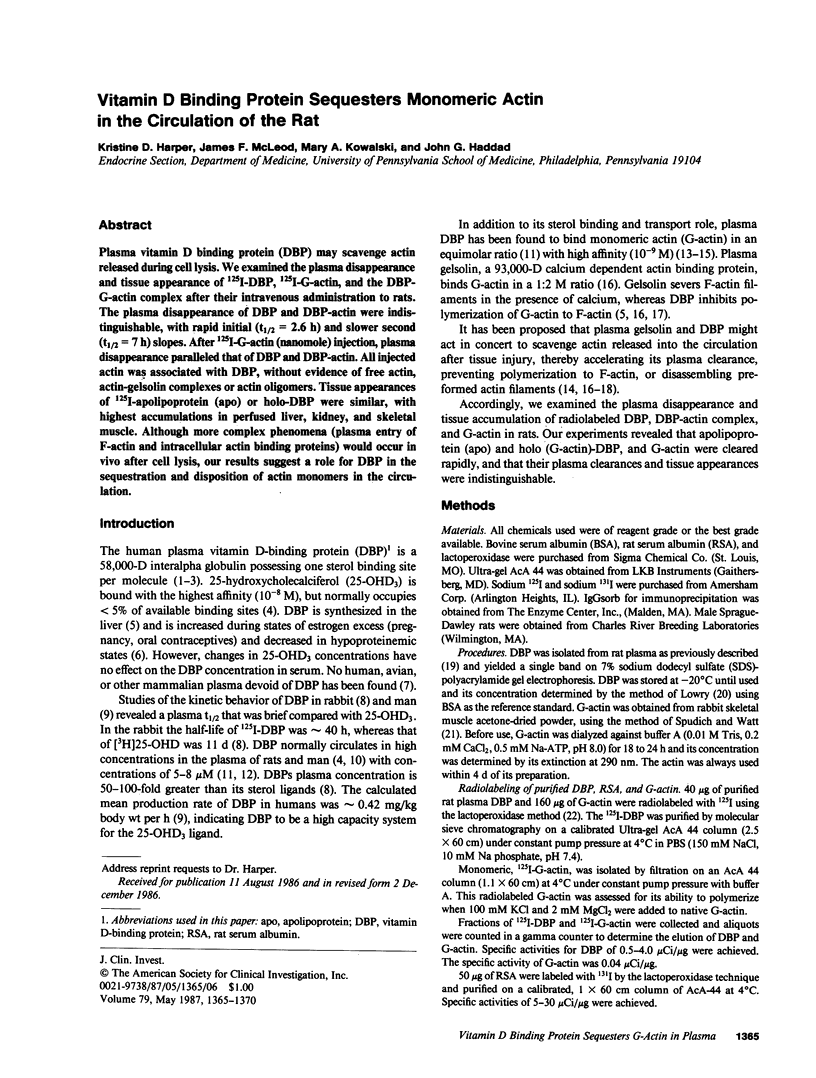
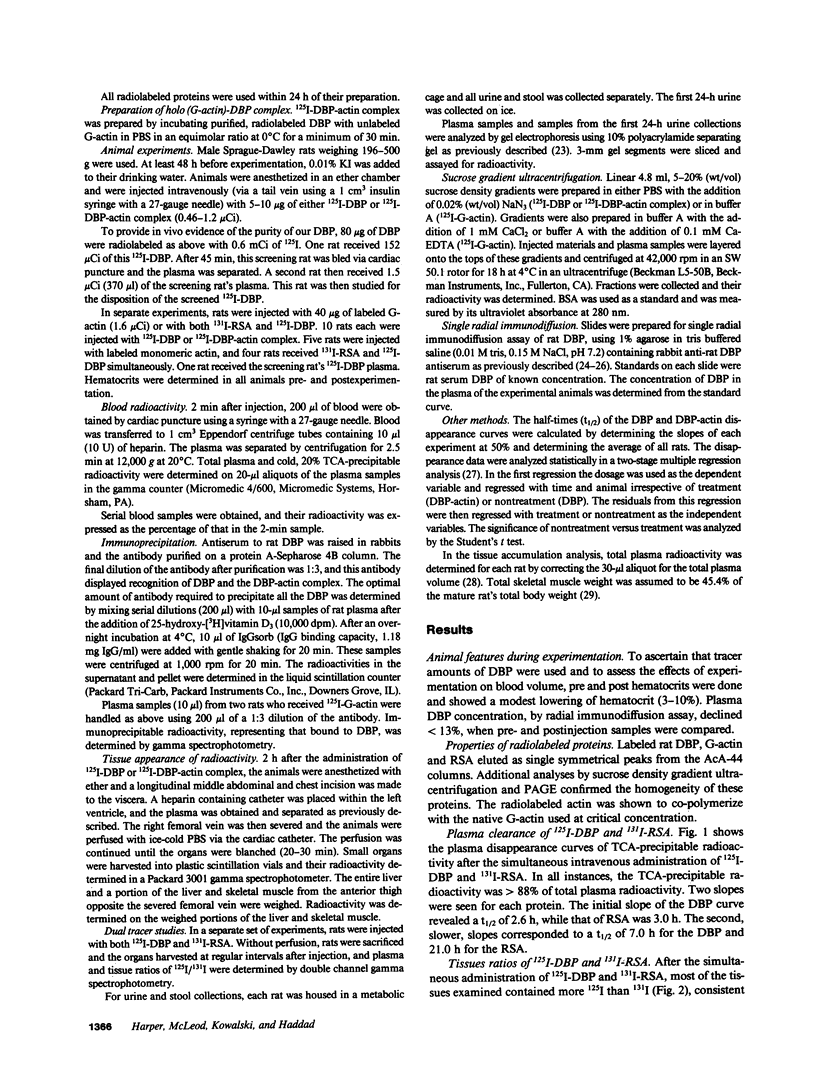
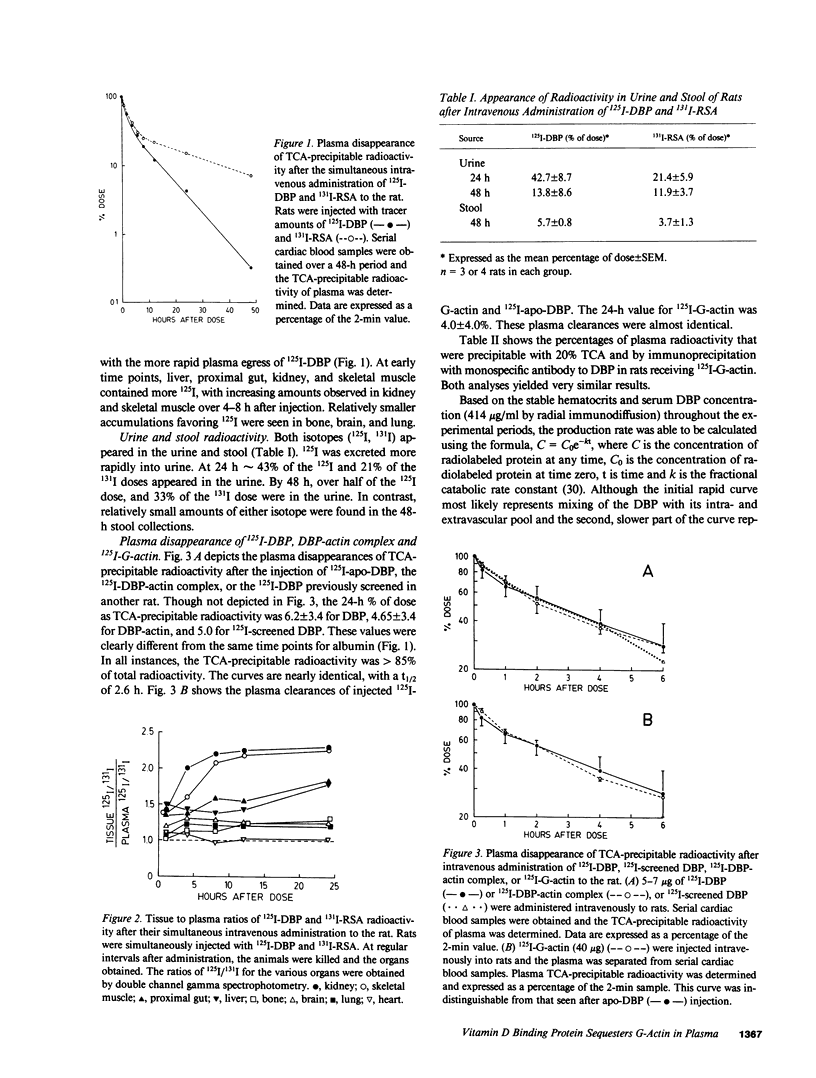
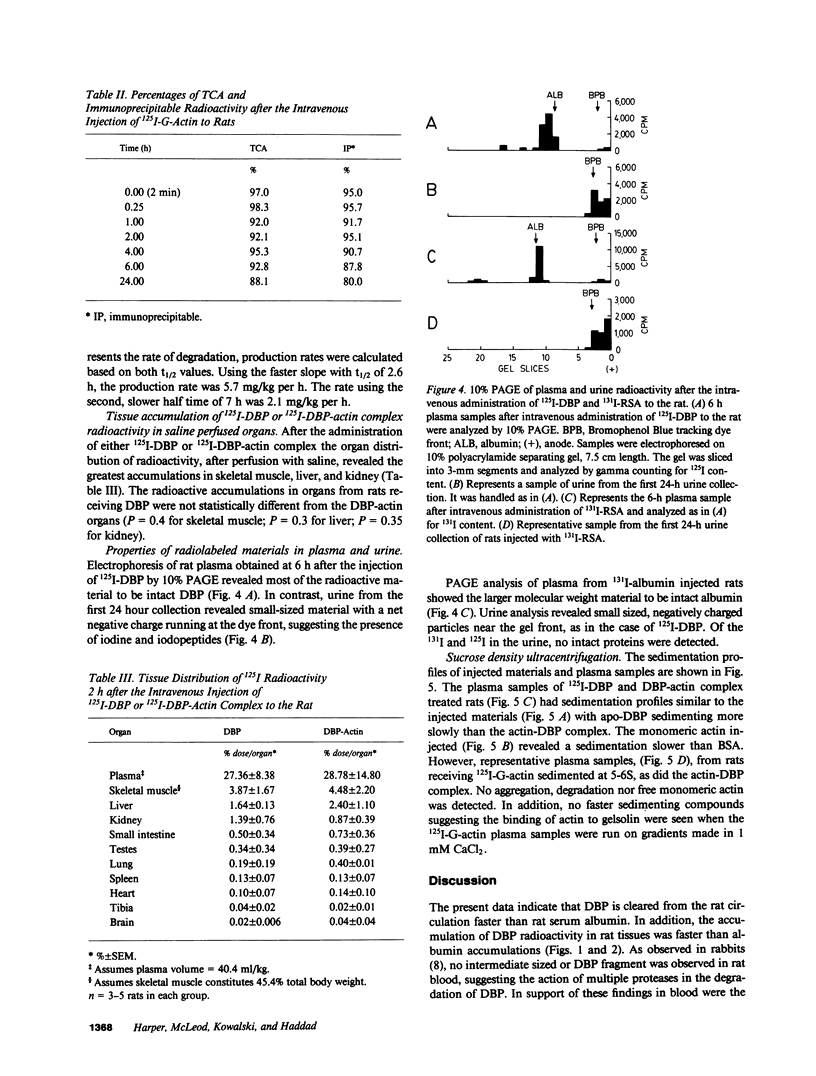
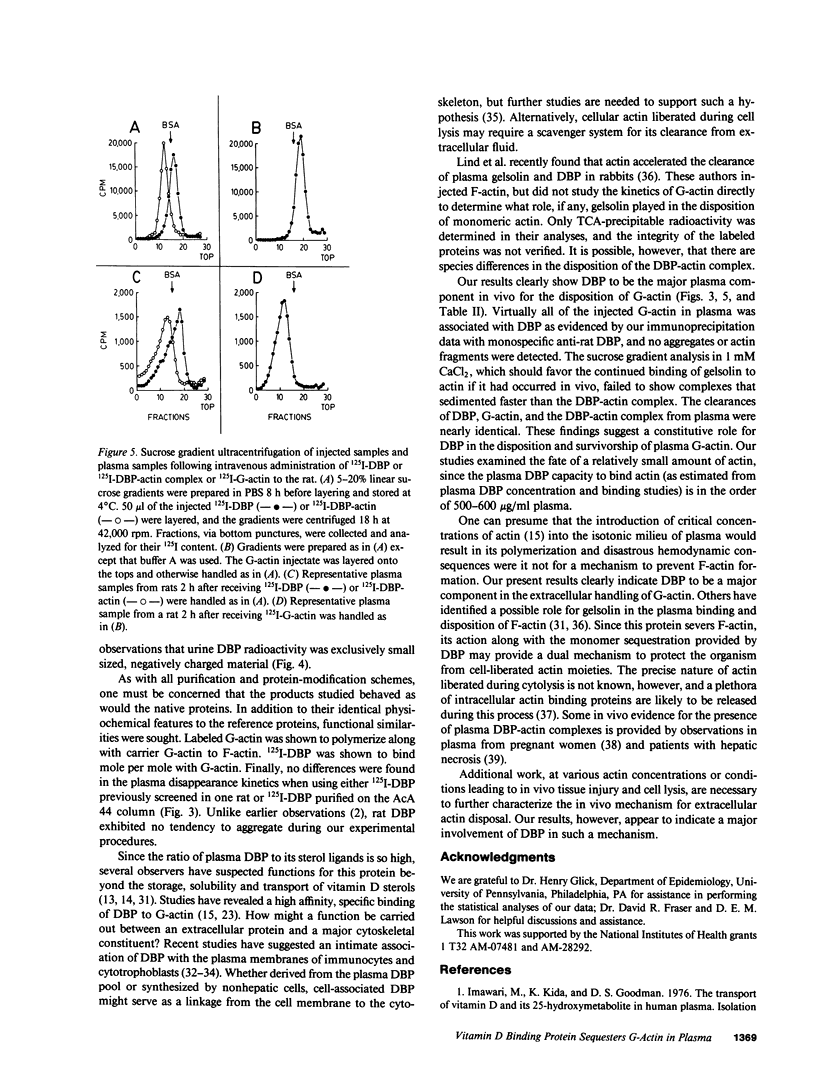
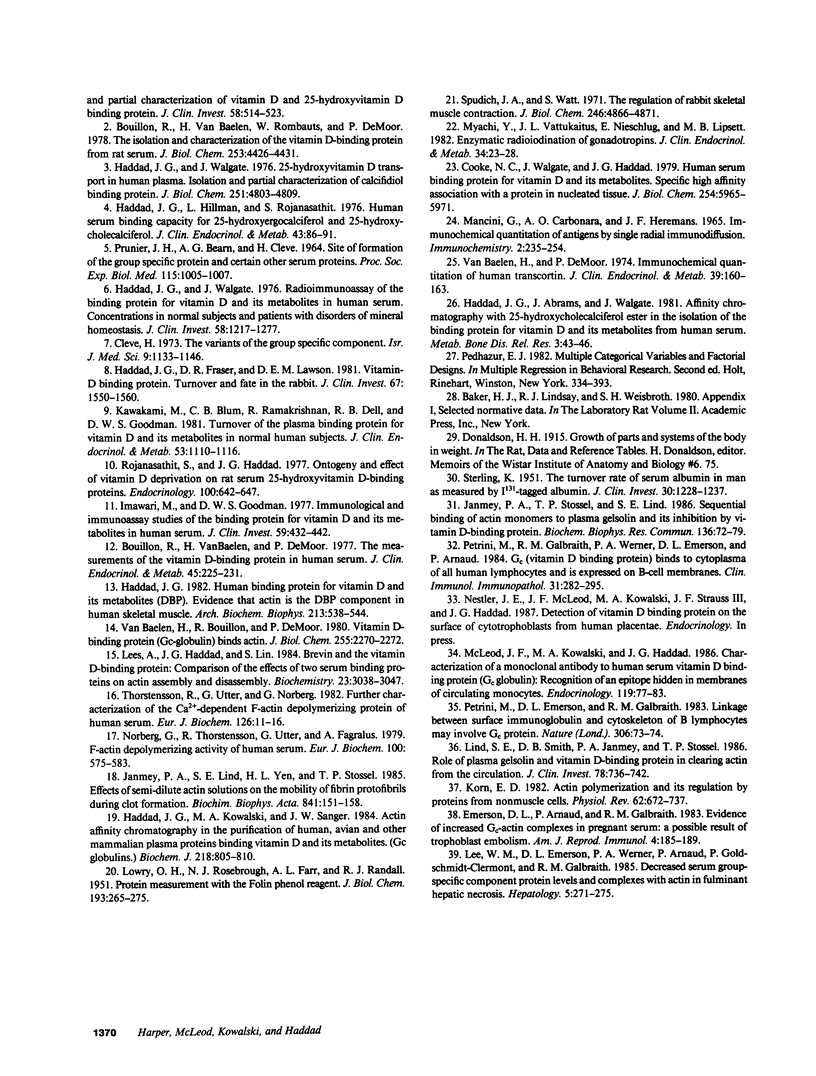
Selected References
These references are in PubMed. This may not be the complete list of references from this article.
- Bouillon R., Van Baelen H., Rombauts W., de Moor P. The isolation and characterization of the vitamin D-binding protein from rat serum. J Biol Chem. 1978 Jun 25;253(12):4426–4431. [PubMed] [Google Scholar]
- Bouillon R., van Baelen H., de Moor P. The measurement of the vitamin D-binding protein in human serum. J Clin Endocrinol Metab. 1977 Aug;45(2):225–231. doi: 10.1210/jcem-45-2-225. [DOI] [PubMed] [Google Scholar]
- Cleve H. The variants of the group-specific component. A review of their distribution in human populations. Isr J Med Sci. 1973 Sep-Oct;9(9):1133–1146. [PubMed] [Google Scholar]
- Cooke N. E., Walgate J., Haddad J. G., Jr Human serum binding protein for vitamin D and its metabolites. II. Specific, high affinity association with a protein in nucleated tissue. J Biol Chem. 1979 Jul 10;254(13):5965–5971. [PubMed] [Google Scholar]
- Emerson D. L., Arnaud P., Galbraith R. M. Evidence of increased Gc:actin complexes in pregnant serum: a possible result of trophoblast embolism. Am J Reprod Immunol. 1983 Dec;4(4):185–189. doi: 10.1111/j.1600-0897.1983.tb00276.x. [DOI] [PubMed] [Google Scholar]
- Haddad J. G., Fraser D. R., Lawson D. E. Vitamin D plasma binding protein. Turnover and fate in the rabbit. J Clin Invest. 1981 May;67(5):1550–1560. doi: 10.1172/JCI110186. [DOI] [PMC free article] [PubMed] [Google Scholar]
- Haddad J. G., Hillman L., Rojanasathit S. Human serum binding capacity and affinity for 25-hydroxyergocalciferol and 25-hydroxycholecalciferol. J Clin Endocrinol Metab. 1976 Jul;43(1):86–91. doi: 10.1210/jcem-43-1-86. [DOI] [PubMed] [Google Scholar]
- Haddad J. G. Human serum binding protein for vitamin D and its metabolites (DBP): evidence that actin is the DBP binding component in human skeletal muscle. Arch Biochem Biophys. 1982 Feb;213(2):538–544. doi: 10.1016/0003-9861(82)90581-1. [DOI] [PubMed] [Google Scholar]
- Haddad J. G., Jr, Walgate J. 25-Hydroxyvitamin D transport in human plasma. Isolation and partial characterization of calcifidiol-binding protein. J Biol Chem. 1976 Aug 25;251(16):4803–4809. [PubMed] [Google Scholar]
- Haddad J. G., Jr, Walgate J. Radioimmunoassay of the binding protein for vitamin D and its metabolites in human serum: concentrations in normal subjects and patients with disorders of mineral homeostasis. J Clin Invest. 1976 Nov;58(5):1217–1222. doi: 10.1172/JCI108575. [DOI] [PMC free article] [PubMed] [Google Scholar]
- Haddad J. G., Kowalski M. A., Sanger J. W. Actin affinity chromatography in the purification of human, avian and other mammalian plasma proteins binding vitamin D and its metabolites (Gc globulins). Biochem J. 1984 Mar 15;218(3):805–810. doi: 10.1042/bj2180805. [DOI] [PMC free article] [PubMed] [Google Scholar]
- Imawari M., Goodman D. S. Immunological and immunoassay studies of the binding protein for vitamin D and its metabolites in human serum. J Clin Invest. 1977 Mar;59(3):432–442. doi: 10.1172/JCI108657. [DOI] [PMC free article] [PubMed] [Google Scholar]
- Imawari M., Kida K., Goodman D. S. The transport of vitamin D and its 25-hydroxy metabolite in human plasma. Isolation and partial characterization of vitamin D and 25-hydroxyvitamin D binding protein. J Clin Invest. 1976 Aug;58(2):514–523. doi: 10.1172/JCI108495. [DOI] [PMC free article] [PubMed] [Google Scholar]
- Janmey P. A., Lind S. E., Yin H. L., Stossel T. P. Effects of semi-dilute actin solutions on the mobility of fibrin protofibrils during clot formation. Biochim Biophys Acta. 1985 Aug 16;841(2):151–158. doi: 10.1016/0304-4165(85)90016-9. [DOI] [PubMed] [Google Scholar]
- Janmey P. A., Stossel T. P., Lind S. E. Sequential binding of actin monomers to plasma gelsolin and its inhibition by vitamin D-binding protein. Biochem Biophys Res Commun. 1986 Apr 14;136(1):72–79. doi: 10.1016/0006-291x(86)90878-8. [DOI] [PubMed] [Google Scholar]
- Kawakami M., Blum C. B., Ramakrishnan R., Dell R. B., Goodman D. S. Turnover of the plasma binding protein for vitamin D and its metabolites in normal human subjects. J Clin Endocrinol Metab. 1981 Dec;53(6):1110–1116. doi: 10.1210/jcem-53-6-1110. [DOI] [PubMed] [Google Scholar]
- Korn E. D. Actin polymerization and its regulation by proteins from nonmuscle cells. Physiol Rev. 1982 Apr;62(2):672–737. doi: 10.1152/physrev.1982.62.2.672. [DOI] [PubMed] [Google Scholar]
- LOWRY O. H., ROSEBROUGH N. J., FARR A. L., RANDALL R. J. Protein measurement with the Folin phenol reagent. J Biol Chem. 1951 Nov;193(1):265–275. [PubMed] [Google Scholar]
- Lee W. M., Emerson D. L., Werner P. A., Arnaud P., Goldschmidt-Clermont P., Galbraith R. M. Decreased serum group-specific component protein levels and complexes with actin in fulminant hepatic necrosis. Hepatology. 1985 Mar-Apr;5(2):271–275. doi: 10.1002/hep.1840050220. [DOI] [PubMed] [Google Scholar]
- Lees A., Haddad J. G., Lin S. Brevin and vitamin D binding protein: comparison of the effects of two serum proteins on actin assembly and disassembly. Biochemistry. 1984 Jun 19;23(13):3038–3047. doi: 10.1021/bi00308a030. [DOI] [PubMed] [Google Scholar]
- Lind S. E., Smith D. B., Janmey P. A., Stossel T. P. Role of plasma gelsolin and the vitamin D-binding protein in clearing actin from the circulation. J Clin Invest. 1986 Sep;78(3):736–742. doi: 10.1172/JCI112634. [DOI] [PMC free article] [PubMed] [Google Scholar]
- Mancini G., Carbonara A. O., Heremans J. F. Immunochemical quantitation of antigens by single radial immunodiffusion. Immunochemistry. 1965 Sep;2(3):235–254. doi: 10.1016/0019-2791(65)90004-2. [DOI] [PubMed] [Google Scholar]
- McLeod J. F., Kowalski M. A., Haddad J. G. Characterization of a monoclonal antibody to human serum vitamin D binding protein (Gc globulin): recognition of an epitope hidden in membranes of circulating monocytes. Endocrinology. 1986 Jul;119(1):77–83. doi: 10.1210/endo-119-1-77. [DOI] [PubMed] [Google Scholar]
- Miyachi Y., Vaitukaitis J. L., Nieschlag E., Lipsett M. B. Enzymatic radioiodination of gonadotropins. J Clin Endocrinol Metab. 1972 Jan;34(1):23–28. doi: 10.1210/jcem-34-1-23. [DOI] [PubMed] [Google Scholar]
- Norberg R., Thorstensson R., Utter G., Fagraeus A. F-Actin-depolymerizing activity of human serum. Eur J Biochem. 1979 Oct 15;100(2):575–583. doi: 10.1111/j.1432-1033.1979.tb04204.x. [DOI] [PubMed] [Google Scholar]
- PRUNIER J. H., BEARN A. G., CLEVE H. SITE OF FORMATION OF THE GROUP-SPECIFIC COMPONENT AND CERTAIN OTHER SERUM PROTEINS. Proc Soc Exp Biol Med. 1964 Apr;115:1005–1007. doi: 10.3181/00379727-115-29101. [DOI] [PubMed] [Google Scholar]
- Petrini M., Emerson D. L., Galbraith R. M. Linkage between surface immunoglobulin and cytoskeleton of B lymphocytes may involve Gc protein. Nature. 1983 Nov 3;306(5938):73–74. doi: 10.1038/306073a0. [DOI] [PubMed] [Google Scholar]
- Petrini M., Galbraith R. M., Werner P. A., Emerson D. L., Arnaud P. Gc (vitamin D binding protein) binds to cytoplasm of all human lymphocytes and is expressed on B-cell membranes. Clin Immunol Immunopathol. 1984 May;31(2):282–295. doi: 10.1016/0090-1229(84)90248-4. [DOI] [PubMed] [Google Scholar]
- Rojanasathit S., Haddad J. G. Ontogeny and effect of vitamin D deprivation on rat serum 25-hydroxyvitamin D binding protein. Endocrinology. 1977 Mar;100(3):642–647. doi: 10.1210/endo-100-3-642. [DOI] [PubMed] [Google Scholar]
- STERLING K. The turnover rate of serum albumin in man as measured by I131-tagged albumin. J Clin Invest. 1951 Nov;30(11):1228–1237. doi: 10.1172/JCI102542. [DOI] [PMC free article] [PubMed] [Google Scholar]
- Spudich J. A., Watt S. The regulation of rabbit skeletal muscle contraction. I. Biochemical studies of the interaction of the tropomyosin-troponin complex with actin and the proteolytic fragments of myosin. J Biol Chem. 1971 Aug 10;246(15):4866–4871. [PubMed] [Google Scholar]
- Thorstensson R., Utter G., Norberg R. Further characterization of the Ca2+-dependent F-actin-depolymerizing protein of human serum. Eur J Biochem. 1982 Aug;126(1):11–16. doi: 10.1111/j.1432-1033.1982.tb06738.x. [DOI] [PubMed] [Google Scholar]
- Van Baelen H., Bouillon R., De Moor P. Vitamin D-binding protein (Gc-globulin) binds actin. J Biol Chem. 1980 Mar 25;255(6):2270–2272. [PubMed] [Google Scholar]
- Van Baelen H., De Moor P. Immunochemical quantitation of human transcortin. J Clin Endocrinol Metab. 1974 Jul;39(1):160–163. doi: 10.1210/jcem-39-1-160. [DOI] [PubMed] [Google Scholar]


